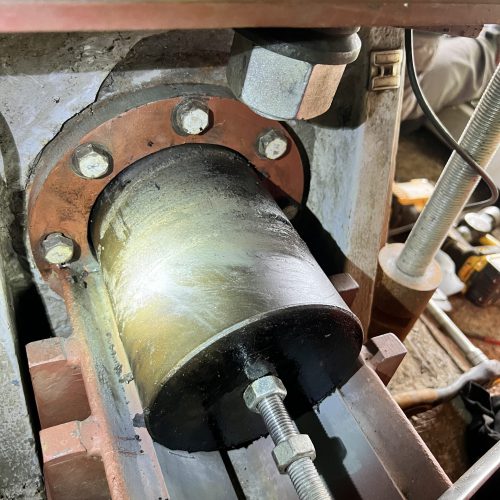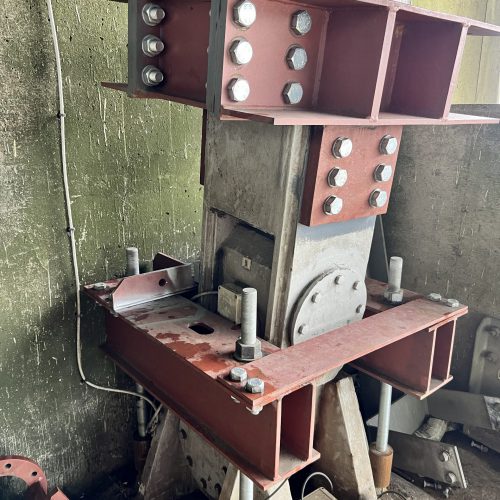The success of a ground breaking project which has trialled the use of a new method to replace the “rockers” which support the Tamar Bridge has saved more than £9 million from the costs of the scheme and significantly reduced potential disruption for bridge users.
Suspension bridge structures are designed to move with traffic and environmental conditions. The Tamar Bridge has steel rocker bearings at the ends of the bridge decks which allow a range of movement as the bridge expands and contracts. The rockers, which act as additional ‘hangers’ next to the bridge towers, support the structure of the bridge, control movements on the deck and protect the expansion joints in the carriageway.
The condition of the rocker bearings is closely monitored by the Tamar Crossings engineering team as part of the bridge’s routine inspection programme which includes inspections of the 1,340 metres of main suspension cables and vertical hanger cables, the gantries, the two giant 76 metre high concrete towers and the main deck and two side spans.
Initial signs of wear on the rocker bearings were first identified in 2007 and since then the team,led by Engineering Manager Richard Cole, has been carrying out targeted inspections to monitor the condition of the rockers.
In 2016, when it became clear that the rockers would need to be replaced within the next few years, the team began work on developing options for the highly complex scheme.
With the investigation showing that a full replacement scheme could not only cost up to £10m, but would also present significant risks to the structure of the bridge and be very disruptive to bridge users because of the lane restrictions and bridge loading restrictions required to carry out the works, the engineering team began to investigate whether there were any viable alternative options.
In 2020 the team began working with engineering consultants to develop a localised repair scheme that would enable the original rocker arms to be retained, with just the worn rocker pins and bearing surfaces repaired or replaced using a technique known as in-line boring.
With initial work on the in-boring option showing promising results, a full scale trial was carried out earlier this year. This also proved successful.
This has been a very complex project which has involved a huge amount of work and taken a considerable amount of time. The success of the trial means that we can confidently use this alternative method for future repairs rather than the significantly more expensive full rocker replacement option, saving £9.5 million and greatly reducing the impact on service delivery and potential risks to the structure of the bridge.
Suspension bridges are complex structures, with many components, and require a very different management approach and a much higher level of inspection and maintenance than other, more simple designs. The Tamar Bridge was opened in 1961 and is currently approximately halfway through its intended design life of 120 years. It now carries a much higher volume of traffic than it was originally expected to carry when it opened in 1961, and much heavier goods vehicles.
During the past 20 years £66.4 million has been invested in major schemes to upgrade and maintain the Tamar Bridge to ensure that it continues to provide a safe and reliable crossing.
This has included major projects such as the innovative and award winning strengthening and widening project carried out between 1999 and 2001, which saw the original three lanes increased to five lanes by adding two extra cantilevers at each side; resurfacing the decks and applying protective coatings; replacing 7,200 kerb units and waterproofing the surface of the decks and suspension system remedial works.
A range of other improvements have also been implemented around the structure. These have included replacement anti-climb prevention measures on the outsides of the north and south cantilever parapets, new access arrangements at either end of the bridge structure to improve safety and efficiency as well as other structural repairs to walkways and other areas of the bridge structure.
The team are also using a new non-destructive technique to inspect the main cable anchorage rods (the vital connections that anchor the main cables into the bridge anchorages buried below ground). Widely used in geotechnical and ground engineering for testing ground anchors and rock anchors, this is thought to be the first time the technique has been used to inspect bridge anchor rods, which are generally much larger and longer than ground or rock anchors.
I am so pleased to receive this news from our world class engineering team following extensive testing. This work is literally breaking new ground in the maintenance of suspension bridges and will provide a significant saving to our budget which comes at a critical time as we strive to reduce costs, whilst maintaining safety and resilience.


